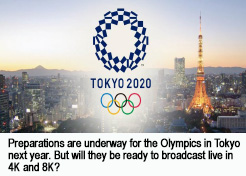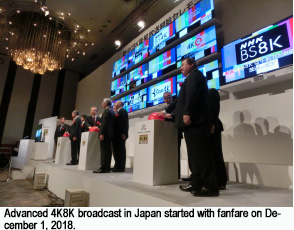Update on the Japanese Satellite Market
by Naoakira Kamiya
Tokyo, Japan, June 1, 2019 — With 21 commercial satellites at the geostationary orbit, Japan is still the largest satellite operating country in the Asia Pacific Region.
Broadcasting Satellite System Corp (B-SAT) currently operates four satellites, BSAT-3a, -3b, -3c and -4a, at 110 degrees east. Unique feature of BSAT-4a satellite is that it carries 12 brand-new left-hand circularly polarized Ku-band transponders in addition to traditional 12 right-hand version.
 In preparation for the 2020 Tokyo Olympic and Paralympic Games, B-SAT ordered one more satellite, BSAT-4b, from SS/Loral in March 2018 to bring additional capacity and backup BSAT-4a. The satellite is tentatively scheduled for launch aboard Ariane-5 rocket in April or May 2020.
In preparation for the 2020 Tokyo Olympic and Paralympic Games, B-SAT ordered one more satellite, BSAT-4b, from SS/Loral in March 2018 to bring additional capacity and backup BSAT-4a. The satellite is tentatively scheduled for launch aboard Ariane-5 rocket in April or May 2020.
There is no doubt that NHK is sweating blood for unprecedented live transmission of coming Olympic and Paralympic Games in 2K, 4K, 8K, and needs, among others, sufficient capacity to expand premium and full-featured in-home experience.
SKY Perfect JSAT Corp (JSAT) operates a large fleet of 17 satellites at the end of February 2019. Their active satellites are located at 85 degrees east (JCSAT-85), 110(JCSAT-110A), 124(JCSAT-4B), 128(JCSAT-3A), 132(JCSAT-5A), 136(N-STAR-C & JCSAT-8), 144(Superbird-C2 & JCSAT-16), 150(JCSAT-6), 154(JCSAT-2B), 162(Superbird-B3), and 169 (JCSAT-12). In addition JSAT has one backup satellite called JCSAT-110R located near 110 degrees east.
Furthermore JSAT and Intelsat jointly own and operate Horizons-1 satellite at 127 degrees west, Horizons-2 at 85 degrees east, and Horizons-3e at 169 degrees east. The latest addition is Horizons-3e, which was launched aboard Ariane-5 rocket on September 26 2018.
Presently JSAT plans to launch two more satellites, JCSAT-17 and JCSAT-18, in the latter half of this year. JCSAT-17 is a state-of-the-art multi-beam satellite of S-band and C-band, and is being built at Lockheed Martin Space Systems in Colorado. On the other hand JCSAT-18 is a joint satellite with Kacific Broadband Satellite and under construction at Boeing Satellite Systems in California. JCSAT-17 satellite is intended for NTT DoCoMo for their high throughput services in Japan. As to launch service, JSAT ordered from Arianespace for JCSAT-17 satellite, and from Space-X for JCSAT-18.
The most important and immediate task for both B-SAT and JSAT is to explode 4K and 8K Ultra HD market by utilizing brand-new left-hand circularly polarized transponders. B-SAT has 12 such transponders on BSAT-4a and JSAT also carries 12 transponders on N-SAT-110A. These transponders have been officially allocated by Ministry of Internal Affairs and Communications (MIC) for 4K and 8K ecosystem.
So far as BSAT-4a is concerned, SC Satellite (Shop Channel 4K,), QVC Satellite (4K QVC), and Tohoku-Shinsya Media Services (Cinema 4K) already started using one such transponder for 4K broadcasting. In addition NHK uses one more transponder for their Super High Vision premium entertainment service in 8K. According to NHK, their 8K broadcasting starts from 10 A.M. and continues for 12 hours and 10 minutes until 10:10 P.M. every day.
B-SAT said WOWOW has committed to use a part of one transponder for their 4K entertainment channel from December 1 2020. Regarding N-SAT-110A, J-Sports 4K, 4K Nihon Eiga + Jidaigeki (Japanese Movie Channel), Star 4K, and Sukachan 4K (SKY Perfect Entertainment Channel) started broadcasting from December 1 2018. J-Sports line up four 4K channels and SKY Perfect Entertainment two channels.
Another important task for all broadcasters in Japan is the transition to IP. So far QVC Satellite and JSAT seemed to have been in most advanced stage.
 QVC Satellite, a subsidiary company of QVC Japan, is broadcasting 4K HDR shopping programs for 24 hours every day and has already adopted IP interface connecting 4K editing facilities and master control room at their renewed broadcasting center in Yokohama. According to QVC Japan, its system integration based on SMPTE ST2110 was carried out by Diversified Media Group in the U.S.
QVC Satellite, a subsidiary company of QVC Japan, is broadcasting 4K HDR shopping programs for 24 hours every day and has already adopted IP interface connecting 4K editing facilities and master control room at their renewed broadcasting center in Yokohama. According to QVC Japan, its system integration based on SMPTE ST2110 was carried out by Diversified Media Group in the U.S.
JSAT adopted IP transmission format called NMI (Network Media Interface) proposed by Sony for its new 4K master control room, which is already in operation from November 2018. According to JSAT, IP offers flexibility and agrees with “the expansion concept of spine and leaf” directed by the management. As was mentioned, JSAT presently offers eight 4K channels on five transponders of JCSAT-110A but aims to use all twelve transponders in near future upon approval from MIC. They also installed two new uplink antennae on the roof of Tokyo Media Center to handle additional 4K traffic.
Meanwhile NHK said that their 8K OB Vans, SHC-2 and SHC-3, were built on SDI/IP hybrid basis, and recently-built 4K OB Vans, 4K-2 and 4K-3, adopted Sony’s IP live production system for delivery interface. NHK presently owns three 4K and three 8K OB Vans and is well prepared for live sports production. Furthermore NHK said that it plans to procure one more 8K OB Van in 2019.
The challenges and opportunities driving the transition to IP delivery of content are well understood by Japanese broadcasters. But 12G-SDI and IP hybrid connections are still prevailing. It is too soon to tell when and how IP transition will be worked out in entire workflows.
As to new satellite business in Japan, Quasi-Zenith Satellite System Services (QSS) is now operating four Quasi-Zenith Satellites (QZS) named “Michibiki” in Japanese. Three satellites, QZS-2, QZS-3, and QZS-4, were launched aboard H-2A rocket during 2017 and full operation including QZS-1 officially started from November 1 2018. Unique features of QSS operation are sub-meter signal called L1S and sub-centimeter signal called CLAS. In addition QSS commenced iPNT (Indoor Position, Navigation, and Timing) and expanded its service area tremendously.
Another new development has been made by Globalstar Japan, which is a joint venture of Globalstar in the US and IPmotion in Japan. They started selling and renting GSP-1700 satellite mobile phone, SPOT Gen3 global satellite GPS messenger, SPOT Trace asset tracking device. In addition they are providing Sat-Fi satellite hot spot services. In October 2018 Globalstar Japan unveiled such equipment and service at their booth of CEATEC Japan exhibition floor and attracted the attention of Japanese satellite professionals. As is known, Inmarsat, Iridium, and Thuraya are already selling and renting satellite mobile phones and providing IoT services in Japan. It is interesting to know how Globalstar Japan will permeate into Japanese market.
Last but not least two pieces of good news have spread out in Japanese satellite community recently.
In terms of Made-in-Japan satellite, Mitsubishi Electric Corp (MELCO) delivered Es’Hail2 to Qatar Satellite Company (Es’Hailsat). MELCO proudly announced that in-orbit tests have been successfully finished and Es’Hail2 entered service at 26 degrees east on March 6 2019. The spacecraft was built by MELCO’s Kamakura Works and launched aboard Falcon-9 on November 15 2018. Es’Hail2 was designed with Ka-band spot beams and Ku-band wide beams for Middle East and Africa region. It is also noteworthy that the satellite carries amateur radio transponders.
Another piece of good news, which was welcomed by Japanese satellite industry, is that SoftBank Group agreed on additional large-scale investment in OneWeb. Exact amount was not disclosed but it is our educated guess that more than half of US$12.5 billion would be invested. However there is no sign yet that the gateway for OneWeb constellation is being constructed in Japan.
----------------------------------
 Naoakira Kamiya is the Managing Director of the Satellite System Research Institute and Director of the Japan Satellite Business Association. He can be reached at: zum05241@nifty.ne.jp
Naoakira Kamiya is the Managing Director of the Satellite System Research Institute and Director of the Japan Satellite Business Association. He can be reached at: zum05241@nifty.ne.jp





